
Amazon is one of the largest retailers in the world. In fact, in the U.S. alone, it’s responsible for about 40 percent of all online sales. And anyone can access a share of the retail giant’s profits — all you need to do is have a website and sign up for the Amazon affiliate program.
Amazon’s affiliate program, also known as Amazon Associates, is an affiliate marketing program that allows users to monetize their websites, blogs or social media. Amazon affiliate users simply place links to Amazon products on their site, and when a customer makes a purchase via one of their links, the user receives a commission. Read on to learn how you can participate in Amazon’s affiliate program and discover strategies you can use to maximize your profits.
What is affiliate marketing?
Affiliate or associate marketing programs like Amazon’s are basically arrangements in which an online merchant like Amazon pays affiliate websites a commission to send them traffic and/or sales. Affiliate sites link to the merchant site and are paid according to the program’s agreements. Amazon’s affiliate program, for example, pays affiliate sites based on the number of people they send to Amazon who also make purchases on the site within 24 hours.
There are several benefits to affiliate marketing for both the merchant and participating affiliates. For the merchant, it’s an opportunity to expand its reach and increase sales through affordable marketing. Because affiliate marketing is performance-based — affiliates are paid only when the desired action takes place — participants in the affiliate program are also motivated to drive conversions.
For affiliates, an associate marketing program provides an opportunity to become involved in ecommerce without having to establish or maintain their own store. It also provides the opportunity to monetize a website, blog or social media and earn a commission.
There are three types of affiliate marketing:
- Pay-per-sale: In this type of program, the merchant pays an affiliate when the affiliate sends a customer who makes a purchase. Some merchants pay the affiliate a fixed rate per sale, while others, like Amazon, pay a percentage of the sale.
- Pay-per-click: In this arrangement, the affiliate is paid based on how many visitors arrive at the merchant’s site via the affiliate link, and the affiliate is paid regardless of whether visitors make a purchase.
- Pay-per-lead: This type of program pays affiliates based on the number of visitors to the merchant’s site who sign up as leads or fill out the requested information on the website.
Amazon falls in the first category, and affiliates can earn as much as $20,000 a year depending on their platform size. So, how does it work?
How does Amazon’s affiliate program work?
Amazon Associates is essentially a referral program that pays a commission to referring websites. So when you send a customer to Amazon via a link on your website, you get a percentage of the sale of whatever they purchase over the next 24 hours.
Your commission varies, though, depending on what type of item a customer purchases. Refer to the chart below to see what Amazon’s fixed standard program fee rate is for various product categories.
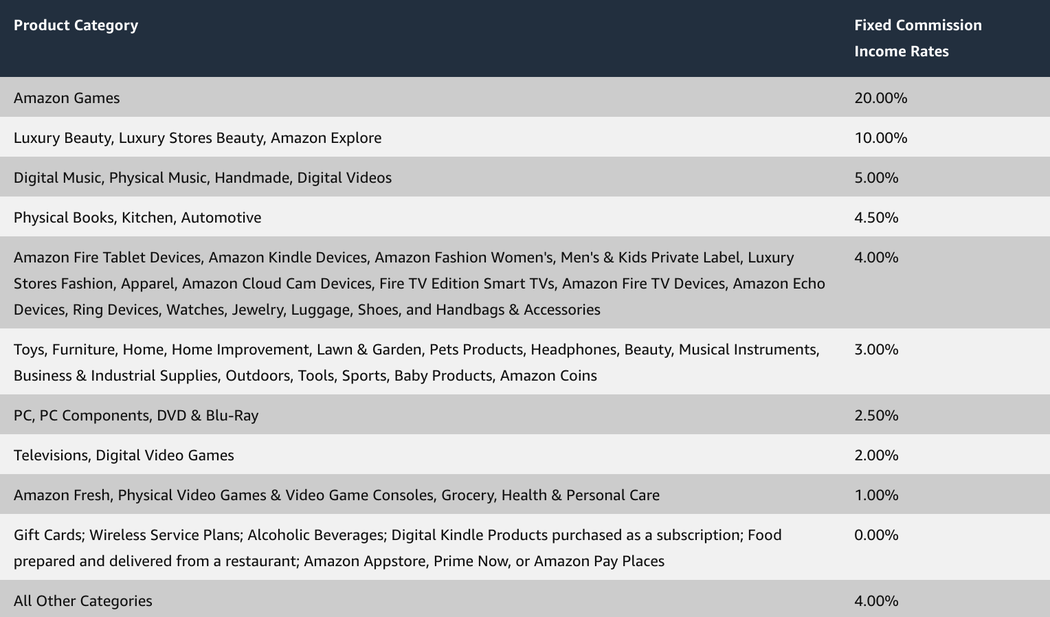
It’s important to keep in mind that the percentage of the sale you receive isn’t the only factor in your commission. Your conversion rate also matters because it reflects how many people are actually clicking an affiliate link and making a purchase after visiting your site.
Your conversion rate is the percentage of visitors to your website who make a purchase via your affiliate link out of the total number of visitors to your site. For example, if during the month of August, your website receives 5,000 visitors and 10 of those visitors made a purchase after clicking on your affiliate link, that would be a conversion rate of 0.2 percent.
The average affiliate conversion rate is 0.5 percent to 1 percent. However, some affiliates regularly have much higher conversion rates.
Estimating your potential Amazon affiliate profits can be tricky and involves more than just your conversion rate and Amazon’s fee rates. Learn more about estimating profits from Amazon Associates links — and get access to a free calculation tool — here.
Because you get a percentage of everything a customer buys from Amazon within 24 hours of when they arrive at Amazon.com from an affiliate link, there’s also the potential to earn more revenue from products that you don’t specifically advertise. For example, if you run a beauty blog that features affiliate links to luxury beauty items, which have a fee rate of 10 percent, you may get 10 percent of the purchase of a high-end moisturizer, but also 8 percent of the cost of a box of dog treats if the customer also purchases biscuits.
However, to earn a commission from Amazon purchases, a customer must place an order within 24 hours of arriving at Amazon.com from your affiliate link. Once that 24-hour window closes — or if the customer re-enters Amazon through another affiliate’s link, you won’t earn any fees from subsequent purchases. However, if the customer returns to Amazon via one of your affiliate links, a new 24-hour window opens, and you’ll again be eligible to earn fees based on the customer’s order.
If a customer arrives at Amazon from one of your affiliate links, adds an item to their shopping cart, and leaves Amazon without completing their order, it’s still possible for you to earn a percentage of that sale. As long as the item was added to the shopper’s cart within that 24-hour window, you’ll receive the referral fee if the order is placed before the shopping cart expires, which is typically 90 days.
Amazon Affiliate program: Pros and cons?
Earning income simply for linking to an Amazon product may seem like a no-brainer, but there are a few things to consider before becoming an Amazon affiliate.
Pros
First, and most importantly, anyone can easily become an Amazon affiliate. You can register and start sharing affiliate links in just a few minutes.
- Amazon is an ecommerce authority. The retail giant is a trusted, well-known brand, so affiliates don’t need to sell visitors on purchasing from the website.
- There are many products to advertise. With more than 3 billion items for sale, in addition to services like Prime Video, there’s no shortage of products to promote via affiliate links.
- Participants earn income from products besides the ones they link to. When you send traffic to Amazon via an affiliate link, and that user makes a purchase, you get a percentage of everything they purchase within 24 hours. And because Amazon is skilled at conversion and upselling, it’s very likely that a customer will add multiple items to their cart.
Cons
A major downside to Amazon’s affiliate program is that commissions are very low in some categories. While the Amazon Associates program has a commission rate of up to 10 percent for some items, such as luxury beauty products, others, such as video game consoles, are as low as 1 percent. Some other cons include:
- The Amazon Associates Program Operating Agreement can be difficult to understand and is frequently updated, so members can easily be found not in compliance if they don’t stay up to date.
- If you don’t already have a website with product reviews or other suitable content that would be a good fit for affiliate links, creating one can require a lot of time, effort, and upkeep.
Given the benefits and challenges, who should become an Amazon affiliate?
Just because you don’t have a personal blog or a website with product reviews doesn’t mean you shouldn’t become an Amazon affiliate. You can launch a website that includes affiliate links to products you endorse and continue to add content and links over time. While your site may not be immediately profitable, this is a good way to create a steady stream of additional income in the long term.
If you have a YouTube channel or are interested in starting one, you can also include affiliate links in YouTube videos. Adding affiliate links to videos can make them more professional and enhance the user experience by providing additional value.
Amazon affiliate links can also be shared on social media sites like Facebook and Twitter, making the affiliate program a great option for anyone who’s active on social media. You don’t need a large following to benefit from using such links. Promoting products you know and love is powerful word-of-mouth marketing, and friends and family may be more likely to take your recommendations because you’re a trusted source.
How to become an Amazon affiliate
Registering for the Amazon Associates program is a simple process. To begin, simply visit affiliate-program.amazon.com and click “Sign up.”
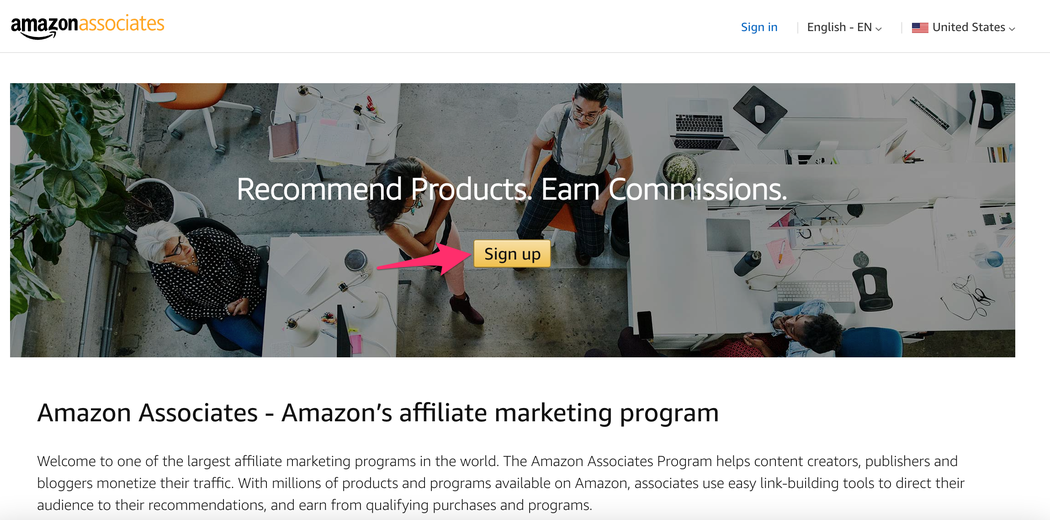
First, you’ll have to enter your account information, including your name, address and phone number. Next, you’ll be asked to enter the websites and mobile app URLs where you plan to display banners, ads or affiliate links. You can enter up to 50 websites and mobile app URLs combined.
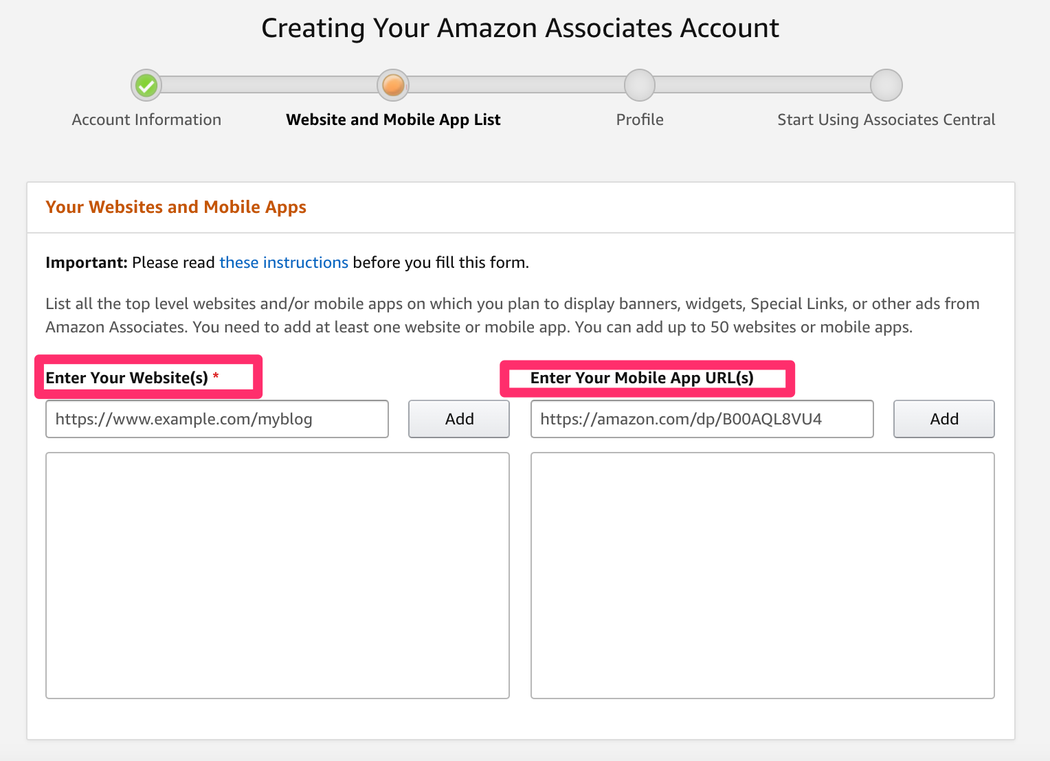
In the following section, you’ll select a store ID and provide information about your websites or mobile apps and what kind of products you intend to promote, as illustrated below.
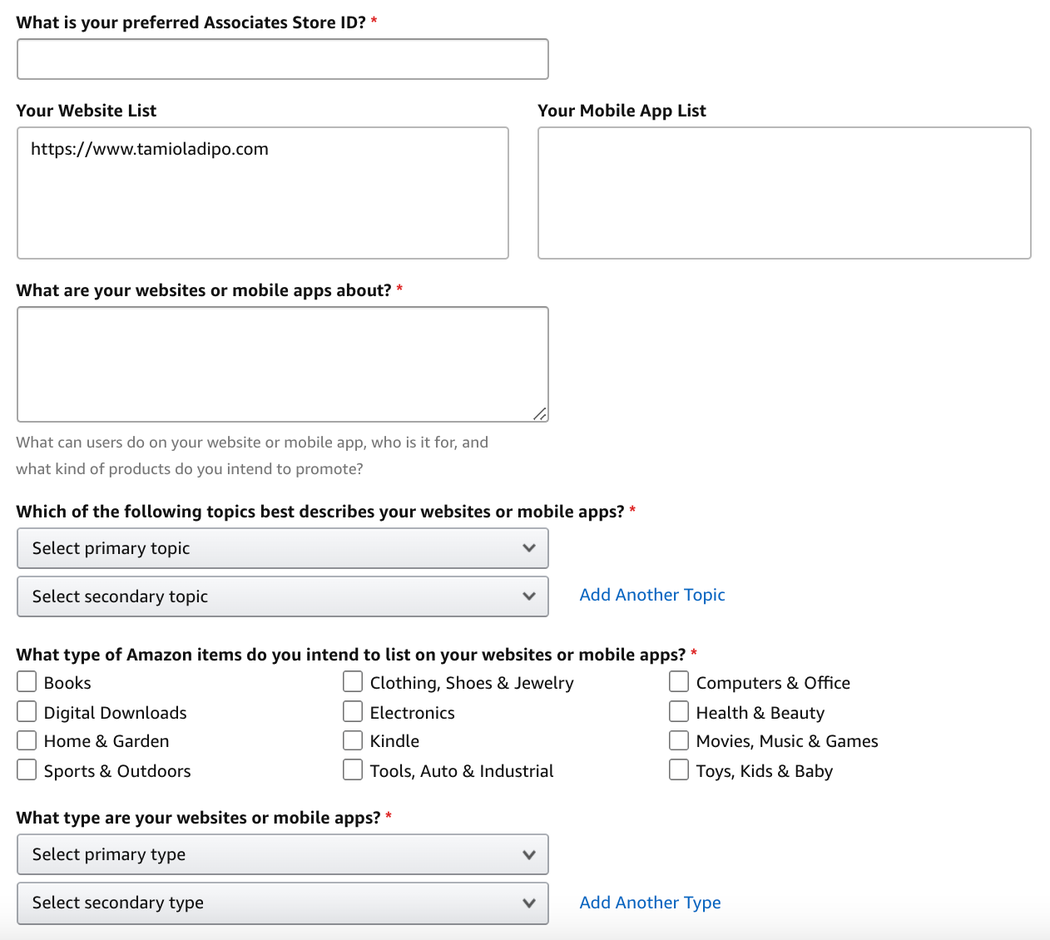
You’ll also choose the topics from a drop-down menu — such as apparel, books, gaming or movies — that best describe your websites or mobile apps.
Next, you’ll need to describe how you drive traffic to your sites, how you generate income from your sites and apps, how you typically build links and how many total unique visitors you get on a monthly basis.
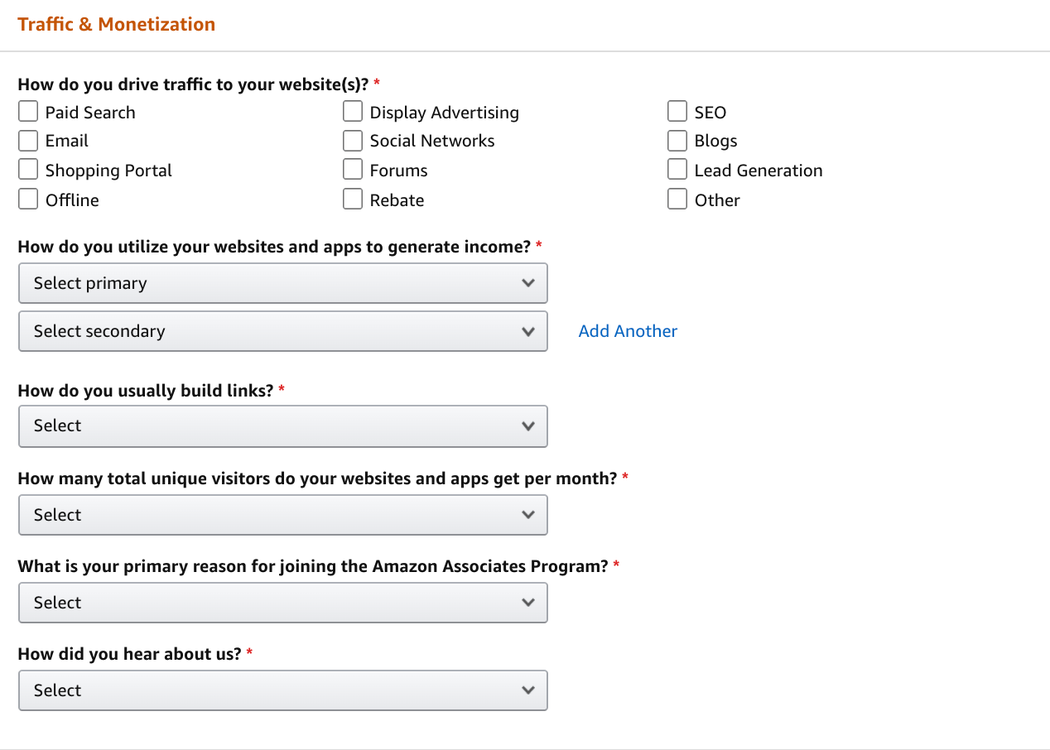
Once this section is complete, you simply have to enter your phone number, click “Call Me Now” and answer when you receive a call from Amazon. You’ll be instructed to input a four-digit PIN, and then your account will be set up.
From here, you can choose whether to enter your payment and tax information now or later, and then proceed to your dashboard to begin creating Amazon affiliate links.
How to create Amazon affiliate links
Once you’ve created your account, you’ll be taken to your Amazon Associates dashboard, where you’ll be able to view a variety of analytics, including earnings revenue, as well as create affiliate links. You can create Amazon affiliate links in two ways: by using the Product Link Tool or using SiteStripe.
Creating affiliate links with Amazon’s Product Link Tool
The Product Link Tool is the most common way to create an affiliate link. To access it, simply click “Product Linking” at the top of the Amazon Associates dashboard and select “Product Links,” as illustrated below.
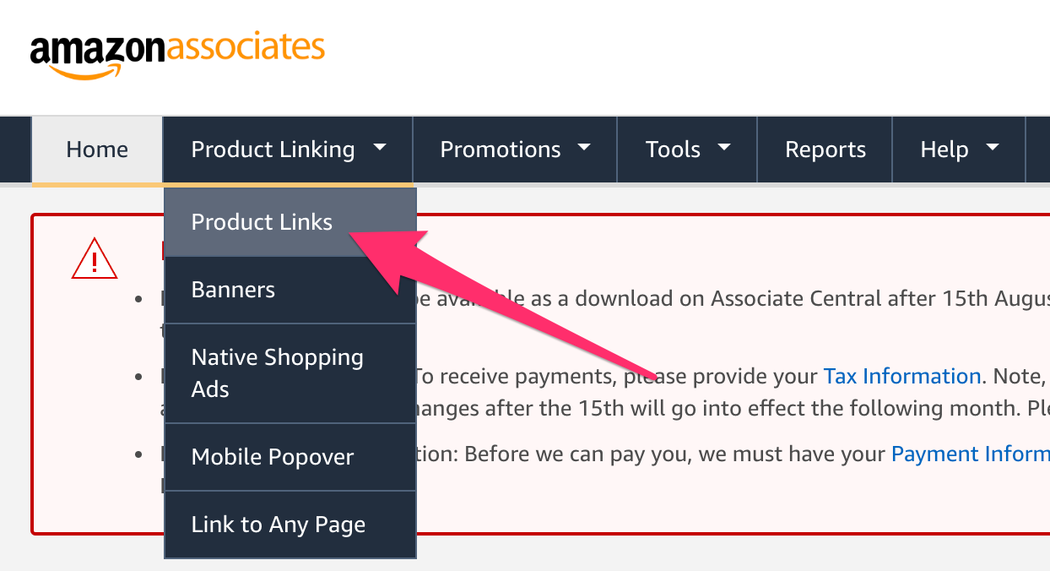
This will take you to a screen where you can search for a product. You can enter a search term that’s fairly generic, such as “headphones,” or you can search for a specific brand, model or product. For example, if you’re creating an affiliate link for a review, you can search for the term “headphones,” or more specifically, for the exact product you’re reviewing, like “Sony Noise Cancelling Headphones.”

Once you’ve entered your query, the search results will appear below, and you can select the product you’d like to create an affiliate link for. To get this link, simply click “Get link” next to the product you’d like to advertise, as in the example below.
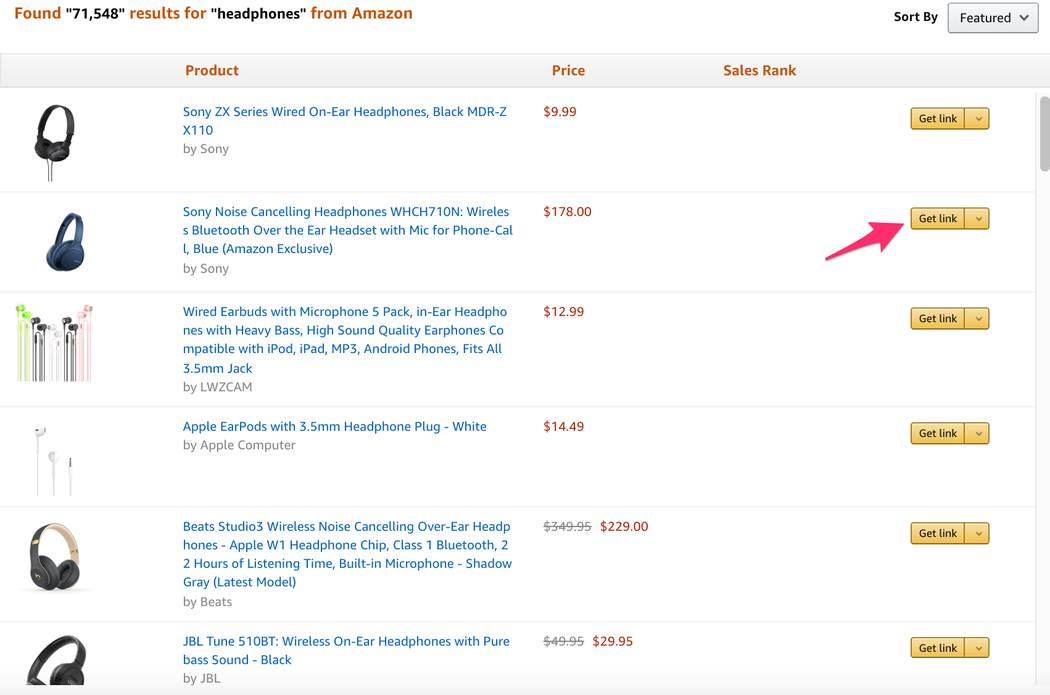
A box will pop up with your affiliate link, and you can copy the HTML code for your site as-is, or you can customize it first. Your ad can be an image and text, just text or an image only. You can also customize the look of the ad. For example, you could change the title or price color to match the branding of your website.
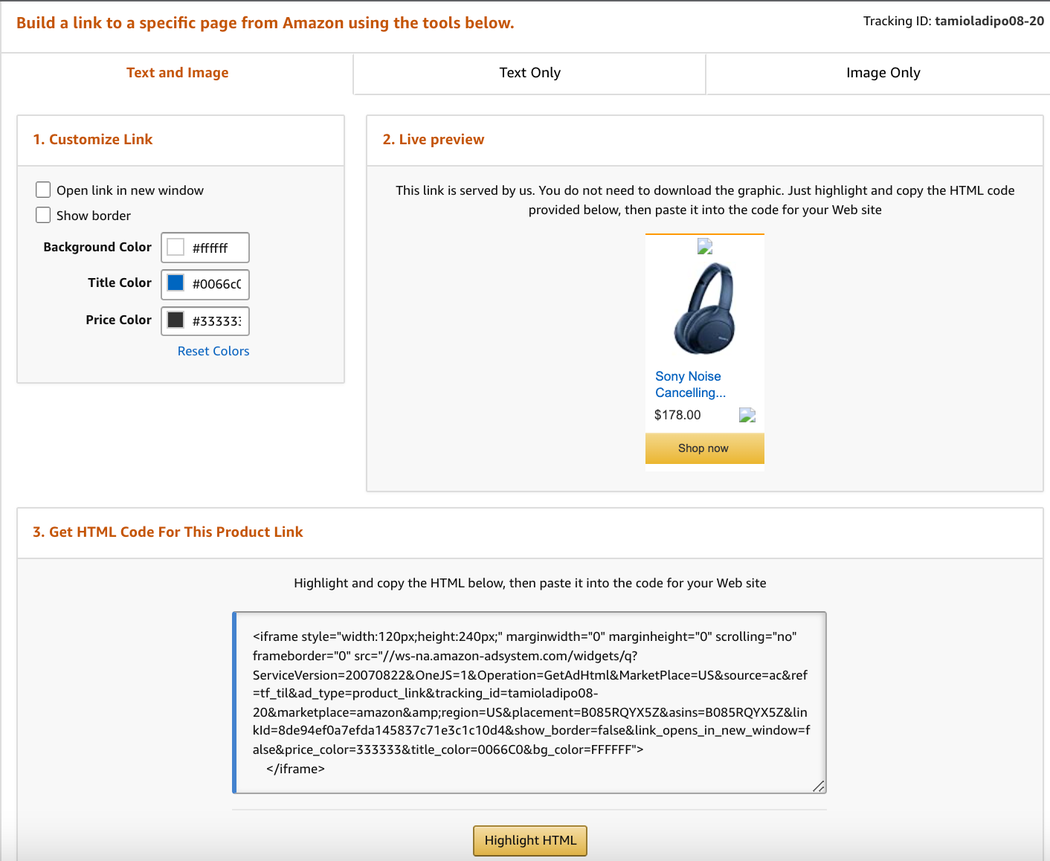
Once the code is copied, simply paste it into the code for your website.
Create affiliate links with SiteStripe
The SiteStripe tool allows you to create an affiliate link directly from any item’s Amazon product page. Once you’ve set up your Amazon Associates account, the tool will automatically appear at the top of any Amazon.com page as long as you’re logged into your account.
To use SiteStripe, simply visit any Amazon product page for the item you’d like to create an affiliate link for.

The SiteStripe bar at the top of the page enables you to create several different types of links. You can create a native ad as illustrated above, or you can get a plain-text link, an image with an embedded link, or a text-plus-image ad. You can also click to share on Facebook or Twitter.
Once you’ve selected the type of affiliate link you’d like, the ad code will appear in a box beneath it, and you’ll simply need to copy the code and paste it on your website or social.
Amazon affiliate program: Getting paid
Profits earned from Amazon’s affiliate program are paid approximately 60 days following the end of each calendar month.
Payments can be made by direct deposit, by check or via Amazon gift card. The payment option you select plays a role in how often you’ll receive payment because Amazon has a minimum payment amount for each type, as indicated below.
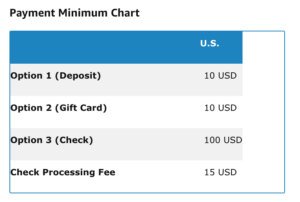
- Direct deposit: If you choose to receive payments via direct deposit, you’ll need to provide Amazon with your banking information, which includes the bank name, account number and other identifying information. Amazon will hold payment until you earn the payment minimum of $10.
- Check: For payment by check, you need to supply Amazon with only a mailing address. Amazon will hold your payment until you reach the minimum payment of $100 + a $15 check-processing fee.
- Amazon gift card: For this payment method, Amazon will send gift cards to the primary email address on your account in the amount you’ve earned. Fees will be held until you reach the payment minimum of $10.
Strategies to maximize profits from the Amazon Affiliate program
Looking to turn your website into a profitable Amazon affiliate site? Try these tips to grow traffic to your site and maximize your Amazon payouts.
1. Find a niche.
Websites that earn most of their revenue through the Amazon Associates program are known as niche sites, and the key to setting up a successful niche site is to first determine which part of the ecommerce marketplace you’ll target.
Finding a profitable, low-competition niche can be challenging, but it’s a good idea to look for a niche that you have knowledge of or an avid interest in. For example, if you’re into natural skincare, you may want to start a beauty blog, or if you’re interested in gaming, you may want to review games or gaming consoles.
Creating review-focused content is one of the best ways to establish a profitable affiliate site; however, it can be repetitive and challenging to upkeep if you’re writing about home improvement products when you have no interest in the topic. You’ll also struggle to create compelling content if you don’t understand the market or the audience you’re targeting.
However, having an interest in your topic alone isn’t enough to make your niche site competitive. Before settling on a niche, do some keyword research to determine how competitive various niches are and which keywords you could most easily rank for.
2. Create regular, original content.
While you can promote Amazon products on social media or on YouTube, most people — including those making six figures from affiliate links — do it by blogging. While writing single product reviews of various Amazon products is a popular option, there are other ways to create review-oriented content that can be more engaging.
Writing roundups of a few similar products can be effective. This could include reviews of the “The 5 Best Handheld Mixers” or creating a roundup of several reviews that declares a winner and a runner-up, such as “The Best Fitness Tracker You Can Buy on Amazon.” For example, in the screenshot from Wirecutter below, the writer reviewed a few mosquito control devices and identified the top pick that performed the best.
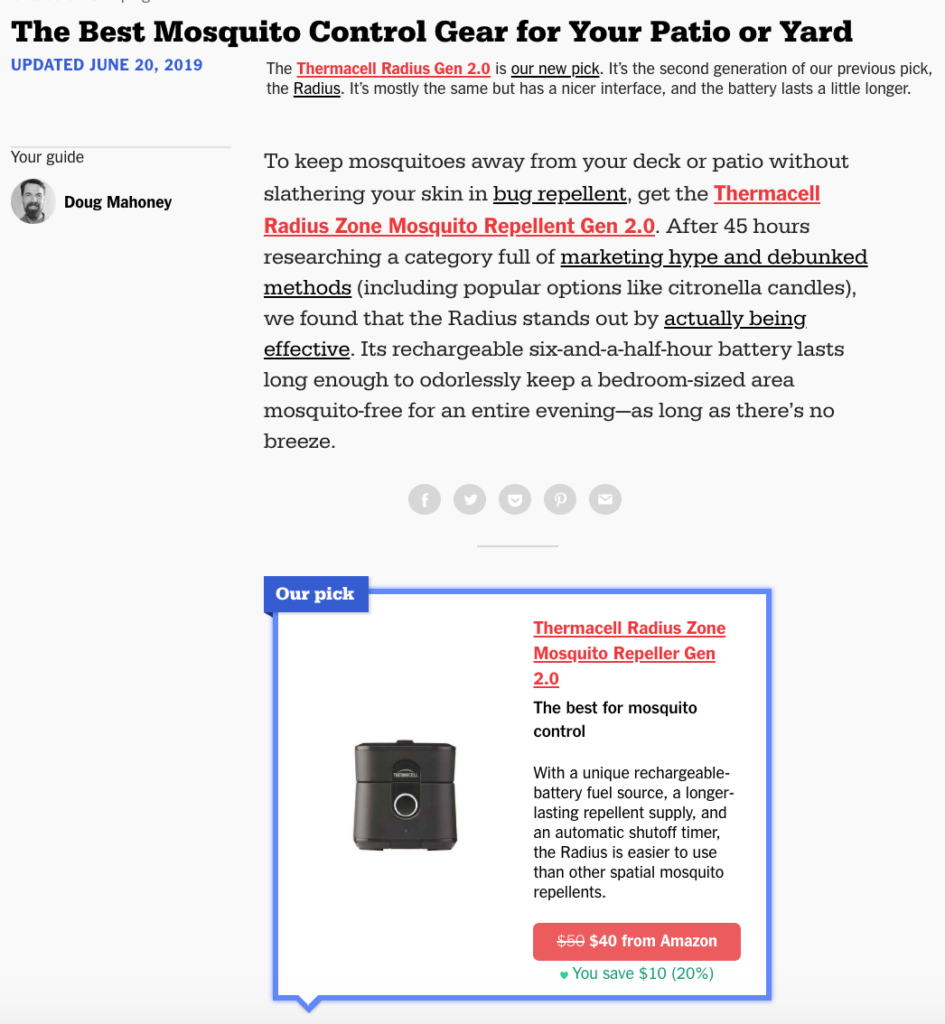
Another option is to create product tutorials or articles that demonstrate how a specific product provides solutions, such as “How to Use Your Ninja Air Fryer” or “10 Tips to Use Your Ninja Air Fryer.” For example, the screenshot from Wirecutter below is from an article titled “How to Back Up Your Computer,” which details the process of backing up a computer and highlights various products you can use.
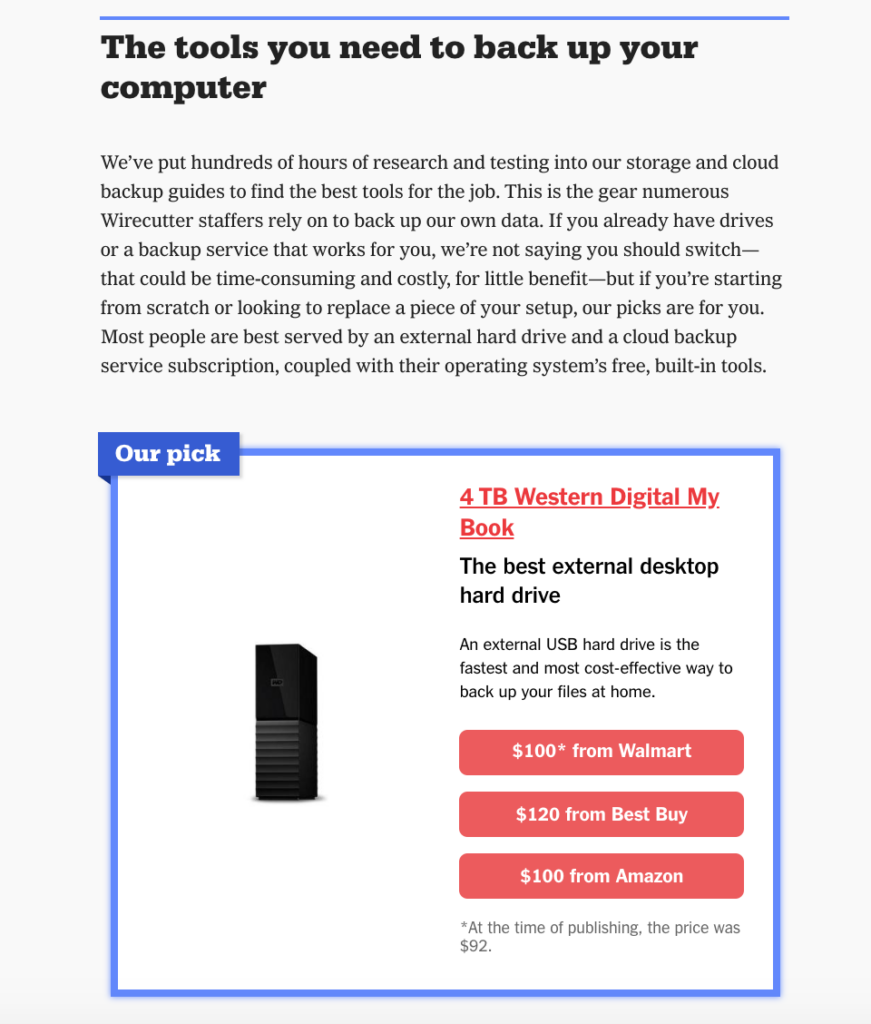
It’s also important to post regularly to keep your site up to date and to create unique content that doesn’t simply rehash a product’s Amazon description. If you’re not testing a product yourself, read other people’s reviews of it to create content that’s both original and useful for potential buyers.
3. Optimize for specific products.
Most traffic to affiliate websites comes from product-related searches or searches for reviews of specific products, so use long-tail terms and use the exact keyword in your URL. For example, if you’re writing a review of a certain appliance, include the product’s brand and model number, such as “Review of AmazonBasics Hardside Spinner Luggage – 28-Inch,” both in the title and the URL if you can.
To learn more about optimizing for search, check out eCommerce SEO — How to boost eCommerce search rankings in 8 steps.
4. Use a link localizer.
Link localizers enable you to redirect visitors from certain countries to a specific site. For example, if a UK-based user visits your website and clicks an Amazon affiliate link, a link localizer will direct the user to amazon.co.uk. If you don’t use a link localizer for your affiliate links, you won’t get paid a commission for the foreign traffic you drive to Amazon.
Is Amazon’s affiliate program right for you?
There’s a lot to consider before signing up for Amazon Associates. If you already have a website with suitable content that you can add affiliate links to, it can be a simple way to start earning additional income in the long term.
If you’re creating a website from scratch with the goal of making it profitable via Amazon affiliate links, the process of launching a site and populating it with reviews and product-related content can be time-consuming. However, developing a niche site optimized with affiliate links also has the possibility of becoming profitable in the short term.